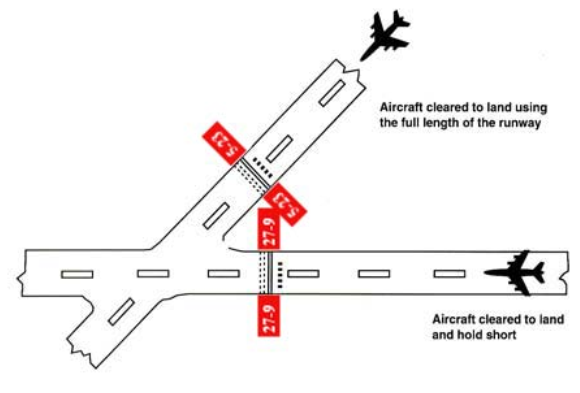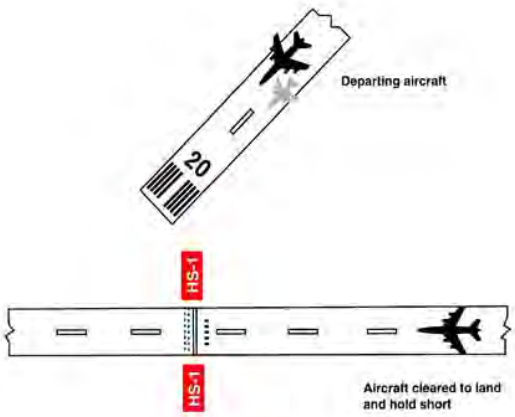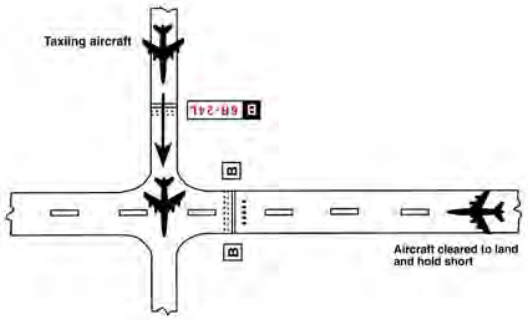Land & Hold Short Operations (LAHSO)
Land and Hold Short Operations is holding short of an intersecting runway, taxiway, or some other designated point on a runway after landing.
Introduction to Land and Hold Short Operations
- Land and Hold Short Operations (LAHSO), formerly Simultaneous Operations on Intersecting Runways (SOIR), is an air traffic control procedure that requires pilot participation to balance the needs for increased airport capacity and system efficiency while/ remaining consistent with safety
- These can include landing and holding short of an intersecting runway, an intersecting taxiway, or some other designated point on a runway other than an intersecting runway or taxiway
LAHSO Preparation
- Like most aspects of aviation, performing an operation such as LAHSO begins on the ground, before you take off
- First, determine if LAHSO is likely at your destination
- This information can be found in the remarks section of the U.S. Chart Supplement for the arrival airport
- If the airport does have LASO then you need to determine your landing performance
- Next, given your expected performance, review the Airport Landing Distance (ALD)
- ALD can be found in the U.S. Chart Supplement and U.S. and in the U.S. Terminal Procedures Publication
- Controllers will provide ALD data upon request
- Keep this information with you during the flight for your reference
- If the controller asks you to hold short of a non-standard, or if you are task saturated, you can always ask the controller for the ALD prior to accepting the clearance
- If caught off-guard by the request upon reaching your destination, ATC can provide landing distance available information
LAHSO Requirements
- Pilots must first be notified that LAHSO operations are in effect by either controllers or ATIS recordings
- The controller must exchange traffic information to both aircraft involved and obtain an acknowledgment from each
- Appropriate runway markings and signs must be installed
- Appropriate runway lighting must be installed and operable
- A VGLI or electronic glide slope is required for the landing runway during the day, and only a VGLI on the landing runway is authorized for night
- The ALD for the landing runway must be free from contaminants (ice, snow, water)
- The weather has to be basic VFR (1000-foot ceiling and 3 miles visibility)
- The tailwind on the hold short runway must be calm (less than 3 knots)
LAHSO Situational Awareness
- Situational awareness is vital to the success of LAHSO. Situational awareness starts with having current airport information in the cockpit, readily accessible to the pilot. (An airport diagram assists pilots in identifying their location on the airport, thus reducing requests for "progressive taxi instructions" from controllers)
- Situational awareness includes effective pilot-controller radio communication. ATC expects pilots to specifically acknowledge and read back all LAHSO clearances as follows:
- ATC: "[Callsign], cleared to land runway 6R, hold short of taxiway bravo for crossing traffic [Type Aircraft]"
- PILOT: "[Callsign], wilco, cleared to land runway 6R, landing aircraft will hold short of taxiway bravo"
- ATC: "[Callsign], cross runway 6R at taxiway bravo, landing aircraft will hold short"
- PILOT: "[Callsign], wilco, cross runway 6R at bravo, landing traffic [Type Aircraft] to hold"
- Once accepted, a LAHSO clearance must be adhered to, just as any other clearance unless amended or an emergency occurs
- Situational awareness also includes a thorough understanding of the airport markings, signage, and lighting associated with LAHSO. These visual aids consist of a three-part system of yellow hold-short markings, red and white signage and, in certain cases, in-pavement lighting. Visual aids assist the pilot in determining where to hold short. Pilots are cautioned that not all airports conducting LAHSO have installed any or all of the above markings, signage, or lighting [Figure 1/2/3]
- Pilots should only receive a LAHSO clearance when VMC exists
- The intent of having "basic" VFR weather (1000' and 3 SM visibility) conditions is to allow pilots to maintain visual contact with other aircraft and ground vehicle operations. Pilots should consider the effects of prevailing inflight visibility (such as landing into the sun) and how it may affect overall situational awareness. Additionally, surface vehicles and aircraft being taxied by maintenance personnel may also be participating in LAHSO, especially in those operations that involve crossing an active runway
LAHSO Procedures
- To conduct LAHSO, pilots should become familiar with all available information concerning LAHSO at their destination airport
- Pilots should have, readily available, the published ALD and runway slope information for all LAHSO runway combinations at each airport of intended landing. Additionally, knowledge about landing performance data permits the pilot to readily determine that the ALD for the assigned runway is sufficient for safe LAHSO
- ALD data is published in the special notices section of the Chart Supplement U.S. and controllers will provide this information on request as well
- As part of a pilot's preflight planning process, pilots should determine if their destination airport has LAHSO. If so, their preflight planning process should include an assessment of which LAHSO combinations would work for them given their aircraft's required landing distance. Good pilot decision-making is knowing in advance whether one can accept a LAHSO clearance if offered
- Pilots should have, readily available, the published ALD and runway slope information for all LAHSO runway combinations at each airport of intended landing. Additionally, knowledge about landing performance data permits the pilot to readily determine that the ALD for the assigned runway is sufficient for safe LAHSO
- If, for any reason, such as difficulty in discerning the location of a LAHSO intersection, wind conditions, aircraft condition, etc., the pilot elects to request to land on the full length of the runway, to land on another runway, or to decline LAHSO, a pilot is expected to promptly inform air traffic, ideally even before the clearance is issued. A LAHSO clearance, once accepted, must be adhered to, just as any other ATC clearance, unless an amended clearance is obtained or an emergency occurs. A LAHSO clearance does not preclude a rejected landing
- A pilot who accepts a LAHSO clearance should land and exit the runway at the first convenient taxiway (unless directed otherwise) before reaching the hold short point. Otherwise, the pilot must stop and hold at the hold short point. If a rejected landing becomes necessary after accepting a LAHSO clearance, the pilot should maintain safe separation from other aircraft or vehicles, and should promptly notify the controller
- Controllers need a full read back of all LAHSO clearances. Pilots should read back their LAHSO clearance and include the words, "HOLD SHORT OF (RUNWAY/TAXIWAY/OR POINT)" in their acknowledgment of all LAHSO clearances. In order to reduce frequency congestion, pilots are encouraged to read back the LAHSO clearance without prompting. Don't make the controller have to ask for a read back!
- If a rejected landing becomes necessary after accepting a LAHSO clearance, the pilot should maintain safe separation from other aircraft or vehicles, and should promptly notify the controller
LAHSO Responsibilities
-
Pilot LAHSO Responsibilities:
- Determine if a destination airport has LAHSO
- Determine the Available Landing DIstance (ALD) as part of preflight planning
- Determine landing performance
- Accept, or deny the LAHSO clearance
- Adhere to a clearance once accepted unless an amended clearance is received
-
Controller LAHSO Responsibilities:
- Solicit LAHSO request
- Provide ALD information as requested
Land and Hold Short Operations Conclusion
- LAHSO operations will be announced by ATIS or the controller, when appropriate
- This procedure can be done safely provided pilots and controllers are knowledgeable and understand their responsibilities
- As the final authority for safety and operation of the aircraft, Pilots-In-Command may accept such a clearance when it is determined the aircraft can safely land and stop (with a safety margin) within the ALD
- Pilots are expected to decline a LAHSO clearance if they determine it will compromise safety
- Student pilots or pilots unfamiliar with LAHSO should not participate in the program
- Good pilot decision-making is knowing in advance whether one can accept a LAHSO clearance if offered
- For those airplanes flown with two crewmembers, effective intra-cockpit communication between cockpit crewmembers is also critical. There have been several instances where the pilot working the radios accepted a LAHSO clearance but then simply forgot to tell the pilot flying the aircraft
- Consideration should be given to braking performance, especially on wet runways
- ATC requests Land and Hold Short when determined that the minimum distances prescribed in FAA Order 7360.1
- Additional resources are available through tools such as the FAA's Runway Safety Simulator
- Still looking for something? Continue searching:
Land and Hold Short Operations References
- Federal Aviation Administration - Pilot/Controller Glossary
- Federal Aviation Administration (JO 7110.118B) Land and Hold Short Operations (LAHSO)
- Federal Aviation Administration (JO 7360.1) Aircraft Type Designators
- Aeronautical Information Manual (4-3-11) Pilot Responsibilities When Conducting Land and Hold Short Operations
- AOPA - Land and Hold Short Operations
- Pilot Workshops - LAHSO Clearance
- FAA - LAHSO Guide


